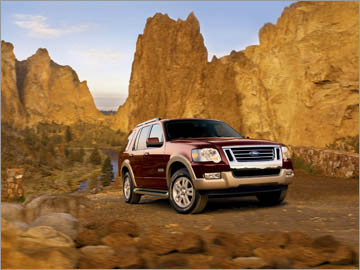|
2006 Ford Explorer Powertrain
MOST POWERFUL AND REFINED EXPLORER
EVER
The 2006 Ford Explorer’s advanced engine
technologies improve both the drive experience and the environment.
The 2006 Explorer with the standard V-6 engine produces 74
percent less smog-forming emissions than the previous model. In
fact, V-6-powered Explorers are expected to be certified to the same
federal tailpipe emissions standards as the Ford Escape Hybrid, the
world’s cleanest SUV.
Additionally, fuel economy for the
all-new 4.6-liter three-valve V-8 engine paired with the new
six-speed transmission is expected to increase by up to 10 percent,
while delivering 53 more horsepower.
“Performance and fuel
economy can go hand-in-hand if you invest in the right
technologies,” says Dave Szczupak, vice president, Powertrain
Operations. “That’s why Ford is investing in six-speed automatic
transmissions, electronic throttles, variable cam timing and other
advanced powertrain technologies.”
Ford has a leadership
position in powertrain technologies such as six-speed automatic
transmissions to simultaneously boost performance — without
necessarily going to larger engines — and fuel economy with
the wider ratio spreads allowed by the extra gear. This investment
in technology is particularly appropriate in the SUV market, where
Ford is increasing capability without resorting to
larger-displacement engines that consume more fuel.
“The
new V-8 and six-speed automatic drivetrain is a tremendous advantage
for the 2006 Explorer,” says Raj Nair, SUV and Body-on-Frame
Vehicles executive director. “Not only does it offer more power,
more refinement and better fuel economy, but it also offers
increased utility. The additional power output helps Explorer
deliver improved payload — up to 1,520 pounds — and a
7,300-pound maximum towing capacity when properly equipped.”
Explorer’s standard powertrain is a refined version of the
SOHC 4.0-liter V-6, paired with a five-speed automatic. Both
powertrains boast modifications to improve noise, vibration, and
harshness.
Three-valve heads,
variable cam timing, muscle car power
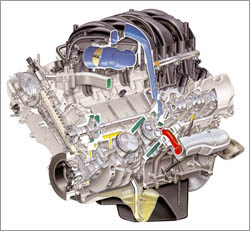
The 2006 Ford Explorer features a new,
4.6-liter, 3-valve V-8 with variable cam timing, delivering 292 hp
and 300 ft.-lbs. of torque.
|
The most
significant powertrain improvement, from the driver’s perspective,
is the new 4.6-liter V-8, with three-valves per cylinder, and single
overhead cams with variable cam timing. These features are common
with the highly lauded 2005 Ford Mustang GT, as well as the
5.4-liter V-8 in the F-Series pickups and Expedition. With the
introduction of the Explorer, Ford Motor Company is approaching one
million three-valve V-8s produced. This multi-application approach
to Ford’s “modular” V-8s delivers benefits in manufacturing
efficiencies, proven customer reliability, and performance.
In the Explorer, the 4.6-liter V-8 delivers 292
horsepower. The slight decrease in output from Mustang’s 300
horsepower can be attributed to a more restrictive exhaust necessary
to accommodate Explorer’s available four-wheel-drive system.
The new head enables a higher compression ratio on regular grade 87
Octane gasoline. Two of the three valves assigned to each cylinder
are intake valves because more airflow into the engine means more
power output. A new, tuned-length exhaust manifold offers optimized
exhaust flow to help scavenge burned gases from the cylinders.
The three-valve heads feature center-mounted sparkplugs
that offer three benefits:
- Placing the sparkplug in the
center of the cylinder provides symmetrical flame for more complete
fuel combustion. This extracts more power from the engine while
decreasing the amount of unconsumed fuel in the exhaust system,
resulting in low emissions
- A longer and narrower spark
plug design enabled powertrain engineers to use larger-diameter
valves, for increased economy and performance
- The compact
coil-on-plug ignition system enables the powertrain control module
(PCM) more precise spark control, again for improved efficiency
The three-valve heads are smaller and lighter than
equivalent four-valve heads. Their large dual intake ports provide
a direct path to the twin intake valves for better airflow at peak
engine speeds. At lower speeds and loads, a charge motion control
valve (CMCV) closes, increasing air velocity and in-cylinder motion
for optimum fuel economy. Likewise, lightweight intake and exhaust
valves reduce inertia for high-speed performance capability, while
enabling lower friction for fuel economy. The cylinder heads are
capped with lightweight magnesium cam covers that help suppress
valvetrain noise.
The ABCs of
VCT
Variable camshaft timing (VCT) plays an
important part in generating more power as well as improving
efficiency and reducing emissions.
The VCT system allows
up to 50 degrees of cam variation in relation to the crankshaft
angle. Ford’s “dual-equal” variable cam timing design shifts the
timing of both the intake and exhaust valves together, with a single
camshaft per cylinder head. This provides all the benefits of
variable valve timing — but creates far less complexity and
adds less weight than VCT systems that actuate the intake valves
separately.
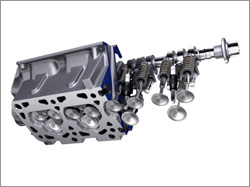
The single-overhead-cam heads feature “dual
equal” variable cam timing that rotates the camshafts up to 50
degrees in relation to the crankshaft.
|
The cam in each cylinder head operates both sets
of valves using low-profile roller-finger followers, helping reduce
friction. The powertrain control module (PCM) directs solenoids to
alter the oil flow in the hydraulic cam timing mechanism, which
rotates the camshafts in relation to their drive sprockets. The
unit can shift between fully advanced and fully retarded in
milliseconds.
The result is enhanced efficiency under
low-load conditions, such as at idle or highway cruising, and
increased power for brisk acceleration for times of high
demand.
Paired with the six-speed automatic, 4×4 V-8 models
are expected to deliver up to a 10 percent increase in fuel economy,
or two miles per gallon. Just as significant, it is anticipated to
qualify for Tier II Bin 5 emissions certification, which is
compliant with California’s Low Emissions Vehicle II (LEV II)
standards.
Class-leading
six-speed automatic transmission
The 4.6-liter V-8
comes standard with a new six-speed 6R automatic transmission,
introducing transmission technology normally found only in luxury
vehicles to the mid-price mid-size SUV segment.
For the
best possible shift quality, each 6R transmission is bench tested at
Ford’s Livonia (Mich.) Transmission Plant. There, the transmission
build quality is verified, detecting even minute variabilities in
the manufacturing process. These variances would normally lead to
changes in shift feel. However, the 6R’s electronic controller is
programmed with its own unique software to account for these
variances, producing smooth, precisely controlled shifts that
improve durability and customer satisfaction.
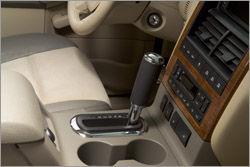
The class-leading, six-speed 6R electronically
controlled transmission features the first console-mounted shifter
in an Explorer.
|
The electronically controlled
transmission offers the smooth shift quality of a luxury car, but is
fully tested for heavy-duty use. In fact, it contributes to the
7,300-pound maximum towing capacity of the V-8 drivetrain. For
example, the torque converter assembly features three friction
plates with improved durability, and increased cooling flow for
heavy-duty, high-load use.
New for 2006, the transmission
selector is mounted on the center console (rather than the steering
column.) As a result, the transmission can be shifted manually with
crisp response, thanks to full electronic solenoid control of the
clutch elements. Lastly, focalized transmission mounts mean an even
greater reduction in NVH levels.
The 6R has a 6.04:1 gear-ratio span. The company’s 5R55W5 automatic
has a span in the range of 4.5:1. The wide ratio span of the 6R
enables the engine to spend more time in the optimum powerband
— either at peak power for acceleration, or at peak efficiency
for more fuel economy.
Cleaner
emissions on standard V-6 engine
Explorer’s standard
4.0-liter SOHC V-6 engine received significant improvements for the
2006 model year as well. New engine calibrations and an improved
emission controls cut smog-forming emissions by 74 percent. Idle
quality was improved by 50 percent, thanks to a new camshaft and
spark plugs.
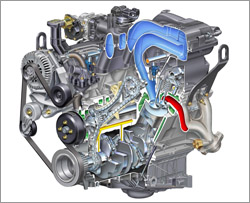
The 4.0-liter SOHC V-6 produces the same 210 hp
of its predecessor, but now produces 74 percent less smog-forming
emissions.
|
Additionally, the 2006 Explorer V-6 is expected to be certified to
the same federal tailpipe emissions standards as Ford’s Escape
Hybrid, the world’s cleanest SUV.
The 4.0-liter V-6 is
rated at 210 horsepower at 5,100 revolutions per minute and 254
foot-pounds at 3,700 revolutions per minute.
The torque
curve is designed to be relatively flat across the entire engine
range and to provide strong performance at nearly any engine speed.
An equal-length composite plastic intake system improves sound
quality.
The V-6 engine comes with a five-speed automatic
transmission. The wide-ratio five-speed 5R55W provides good
acceleration and fuel economy. In addition, the 5R55W has a single
aluminum transmission casting that greatly reduces NVH and
powertrain bending at higher speeds. To reduce noise, it utilizes a
quieter oil pump and planetary gear designs.
Cooling system designed to pass rigors of Ford
truck towing tests
The 2006 Explorer also features
an improved cooling system, delivering increased capability,
decreased NVH, and improved fuel economy.
The clutch that
operates the cooling system fan is now under the command of the
powertrain control module. This electronic control allows the fan
to be operated at just the right time to keep the engine within the
proper range of operating temperature yet not run so long as to draw
off engine power and draw down fuel economy. Controlling when the
fan operates, how long it operates and how fast it operates also
makes it less intrusive in terms of NVH.
The cooling system
is a key component in the Explorer’s impressive payload and towing
capability. One of the most tortuous tests Explorer is subject to
is the Davis Dam towing test in Arizona. The truck is loaded down
to its maximum gross vehicle weight, and then climbs up the Davis
Dam grade as the ambient temperature peaks over 100 degrees. This
is just one of the battery of towing tests Explorer must pass to
certify that its engine and transmission cooling systems are up to
the task, not to mention its engine calibration and system hardware.
New driveshafts improve
NVH
As part of its campaign to elevate refinement of
the 2006 Explorer, Explorer also features new driveshafts.
On V-6 models, the traditional aluminum-tube driveshaft is
engineered for improved balance and decreased run-out.
To
accommodate the longer 6R transmission, V-8 Explorers have new,
improved “slip-in-tube” driveshafts. These feature a pair of
splined tubes that plunge into one another, eliminating the need for
the steel slip and forged stud yokes used in conventional
slip-between-center driveshafts.
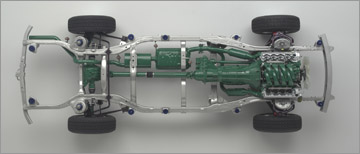
2006 Explorer 4×4 models feature improved
slip-in-tube driveshafts, differential mounts and transfer-case
mounts for improved NVH isolation.
|
The slip-in-tube
driveshaft is more resistant to bending than conventional
driveshafts and thus is inherently less prone to NVH. In addition,
the increased overlap between the tubes enables increased driveshaft
extension, as well as increased durability.
A computer
numerically controlled (CNC) cold rolling spline process is used to
make the slip-in-tube driveshaft. That means that no material
— inside or outside — is machined away. The primary
benefit of this process is that it allows the tubes to slide in and
out of each other easily, even under heavy torque, which eliminates
unpredictable NVH behavior and provides a smooth, quiet ride.
Finally, the rear differential mounts of all 2006
Explorers have been reconfigured for improved isolation, greater
durability and reduced NVH. The differential is suspended by four
mounts: Two, close-set, vertical mounts are connected to the front
of the differential casing, while two vertical mounts have a wider
stance at the rear of the casing. Like the legs of a table, these
wide set mounts better stabilize the differential, for improved
isolation and durability.
Control Trac® delivers automatic torque
split, low-range
Explorer continues to offer the
advanced Control Trac® four-wheel-drive system. It includes
electronic logic and a two-speed transfer case with a locking center
differential.
Control Trac® is an advanced
four-wheel-drive system that allows a driver to select between three
driving modes:
- The 4×4 AUTO (or A4WD) mode provides full
power to the rear axle until the rear wheels begin to slip. Then
power is automatically proportioned to the front axle as required
for increased traction. This mode is appropriate for any driving
condition.
- The 4×4 HIGH (4H) mode effectively locks the
center differential, providing a constant 50/50 torque split between
the front and rear axles. It only is intended for severe winter or
off-road conditions, such as deep snow and ice and shallow sand.
- The 4×4 LOW (4L) mode locks the transfer case and engages
a torque-multiplying gear set in the transfer case. It only is
intended for off-road applications that require extra power
including deep sand, steep grades and towing a boat trailer out of
water.
These powertrain changes help Explorer retain its
leadership, offering genuine SUV capability to tow or go off-road,
without compromising the fuel-economy, refinement, or performance
that have made the Explorer the benchmark of its class.
.
|

